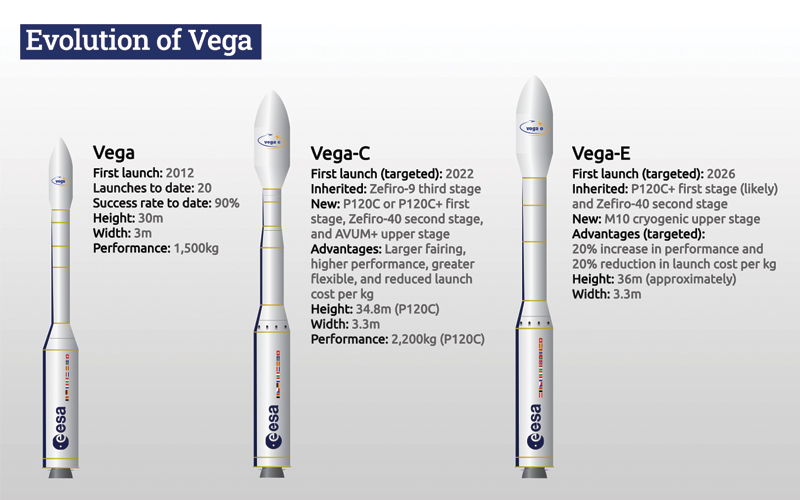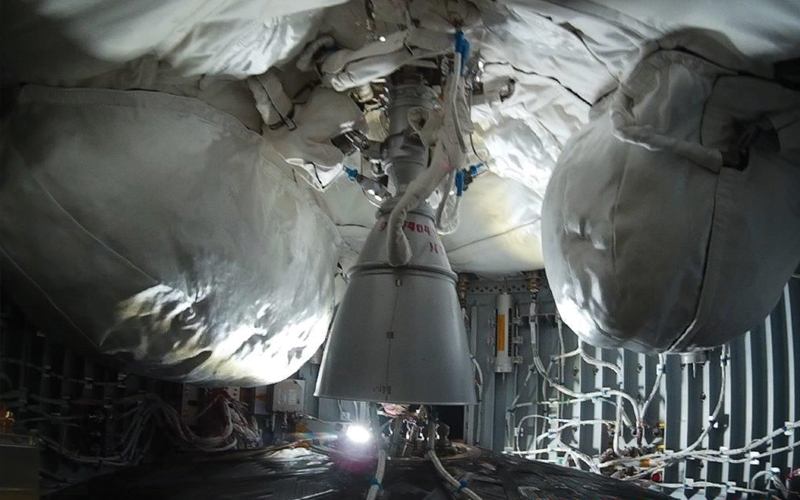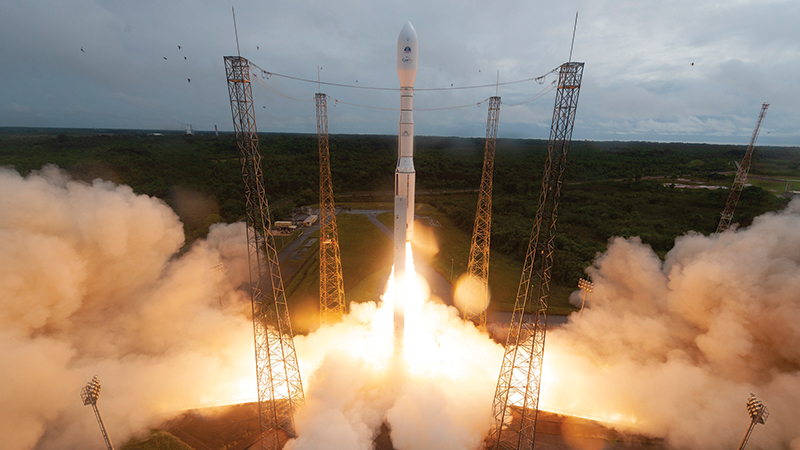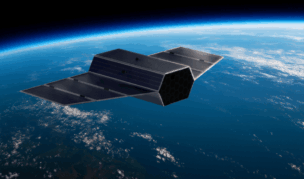The first Avio-built Vega C rocket launched from the Guiana Space Center in French Guiana at 15:13 CET (9:13 ET) today. The mission successfully deployed the LARES2 passive satellite for the Italian space agency (ASI) and six small secondary payloads.
With the first flight of Vega C now complete, the European Space Agency will hand over operational responsibility for the vehicle to Arianespace.
The vehicle
The 35-meter Vega C launch vehicle represents a performance and mission flexibility upgrade from its predecessor, while also reducing the cost-per-kg launch cost.
The new vehicle includes two new solid-fuel rocket stages, including the new P120C booster that will also be utilized by ArianeGroup’s Ariane 6, which is scheduled to make its debut in 2023. Vega C also features an upgraded upper stage, a larger fairing, and new payload adaptors. This equates to an additional 800 kg of payload capacity, enabling the vehicle to carry up to 2.2 t to orbit.
Additionally, Vega C will also be utilized to launch the reusable Space Rider vehicle, which is being developed by Thales Alenia Space and Avio under an ESA contract. This will enable operators at Arianespace to offer Earth-reentry services aboard Vega C when Space Rider is introduced toward the end of 2023.
A European enterprise
Over 20 companies from across Europe are supplying components for Vega C, including Avio, Nammo, Airbus, ArianeGroup, Europropulsion, Beyond Gravity, Leonardo, SENER, RUAG Space, and Ukraine’s Yuzhmash.
“Vega C is a very good example of the successful cooperation of space in Europe,” said ESA Director General Josef Aschbacher. “ESA being the project manager and, of course, industry being the one to deliver. We worked extremely closely with Avio but, of course, also many other companies across Europe.”
Financing was kicked in by Austria, Belgium, the Czech Republic, France, Germany, Ireland, Italy, the Netherlands, Norway, Romania, Spain, Sweden, and Switzerland. Italy contributed more than half of all project costs, with 52% of the funding.
Thanks for flying with Vega C
The primary payload aboard the first Vega C flight was the LARES2 laser reflector. It’s essentially a space disco ball that researchers will shoot lasers at. Their goal? To study the Lense–Thirring effect predicted by Einstein’s General Theory of Relativity.

“The entire LARES2 team, starting from ASI and including the participating engineers and scientists involved in the mission development, is extremely excited for this amazing flight opportunity,” ASI LARES Program Manager Pirrotta Simone told Payload. “We are all looking forward to receiving the first laser signals and starting the analyses to improve the quality of the measurements that LARES2 will allow in several research fields, mainly of Fundamental Physics and Space Geodesy.”
Launching LARES payloads has become something of a tradition for maiden Vega flights. On Feb. 13 2012, when the maiden Vega rocket was launched, it carried the original LARES satellite, which it successfully deployed into orbit. LARES3 for Vega E?
That, need we remind you, was just the primary payload. The launch also carried six cubesats for universities and research outfits from across Europe.
- GreenCube will attempt to grow plants in microgravity remotely. The experiment is fitted with sensors and an internal camera to monitor the health of the plants inside.
- AstroBio aims to test a solution for detecting biomolecules. This technology could be used to monitor astronauts’ health or even search for signs of life as part of planetary exploration missions.
- Trisat-R was developed to improve space radiation modeling in addition to demonstrating techniques for protecting high-performance electronic components.
- MTCube-2 aims to determine what effect space radiation has on different types of flash memory. The satellite will monitor errors while broadcasting messages to the amateur (ham) radio community.
- Celesta will study short circuits in electronic systems caused by energetic particles. The satellite will also enable researchers to compare the radiation environment in orbit with that produced at CERN’s CHARM radiation chamber.
- Alpha was built to study phenomena related to Earth’s magnetosphere, which includes the northern and southern lights. The satellite will also demonstrate technologies designed to mitigate the effects of radiation on spacecraft.
The researchers behind these payloads expressed a great deal of excitement not only about getting to see their missions come to life, but also the chance to be part of the historic mission.
“This launch is one of the key moments of 2022 for all the involved researchers from Sapienza, ENEA, the University of Naples “Federico II” and for the coordination and management team at the Italian Space Agency,” Sapienza Research Associate Paolo Marzioli told Payload. “Not only everyone on our team is very excited about beginning the operations after two and a half years of on-ground development and experimentation, but making this happen on a maiden flight, like the VV21, makes it even more exciting,”
Putting the C in Compromise
As Avio prepared for the maiden launch of Vega in 2012, contingency plans are already in the works for the Vega Evolution (or Vega E) launch vehicle. The primary catalyst behind this planning is Europe’s desire to eliminate the vehicle’s reliance on the Ukrainian-built RD-843, the rocket engine that powers the vehicle’s AVUM upper stage.

In 2014, however, it was decided at an ESA ministerial-level council meeting that Ariane 6 and Vega E would both use a common booster. That booster would go on to become the P120C. Project managers made this decision to cut the development costs of both Ariane 6 and Vega E, which had been in the market for a more powerful first-stage booster.
There was a problem, though.
Although the P120C booster would become operational in 2019 (the original projection), the M10 upper-stage engine wouldn’t be ready until 2024 at the earliest. This meant that the P120C boosters would remain unused by Vega for at least five years, a scenario that was hard to swallow, considering €225 million ($225M) of Vega’s budget had been allocated to the development of the booster.
As a result, during the 2014 council meeting, a compromise was struck. Vega C would be developed to bridge the gap between Vega and Vega E, allowing Avio to make use of the P120C booster while also boosting the performance of the launch vehicle in an increasingly competitive market.
An uncertain future
Despite only just entering the market, the future of Vega C is already uncertain. This uncertainty stems from the availability of the AVUM+ upper stage engine that Avio sources from Ukraine-based Yuzhmash.
The conflict in Ukraine has all but cut off the supply of the engine, with no guarantee that it will come back online soon, if at all.
According to Aschbacher, Avio has a supply of six RD-843 engines, which represent a sufficient supply for manifested launches through 2023.

ESA and Avio are evaluating several options to mitigate the shortage, including the consideration of two unspecified alternative engine options. An acceleration of the development of the M10 methalox engine that will power the Vega E upper stage is also being considered. However, that option would likely entail grounding Vega C for several months, if not years.
With 14 Vega C missions already on its launch manifest through 2025, the vehicle’s upper-stage engine worries could be incredibly disruptive to Europe’s space ambitions if not resolved in a timely fashion.
Today, though, Europe is celebrating the successful launch of its new rocket.
    |




